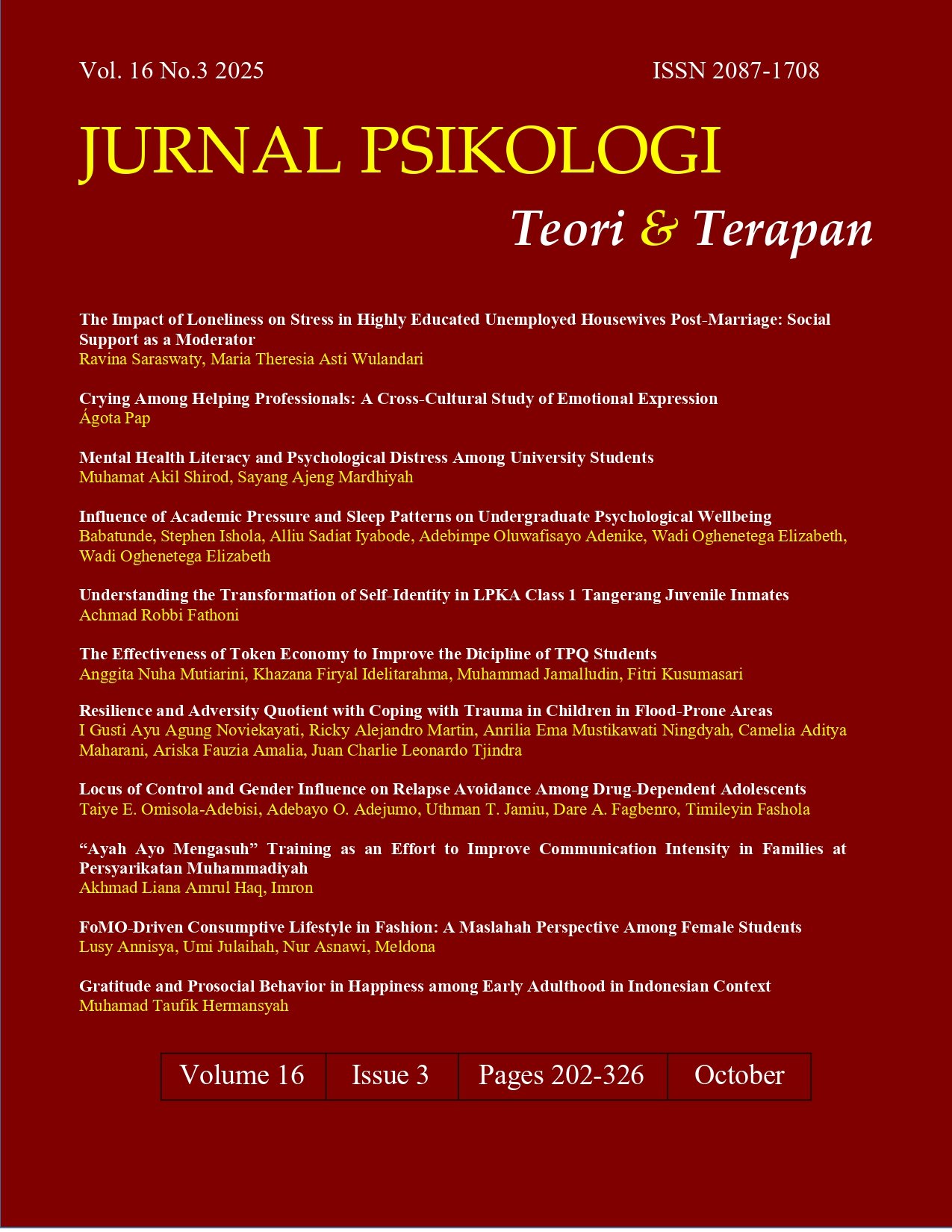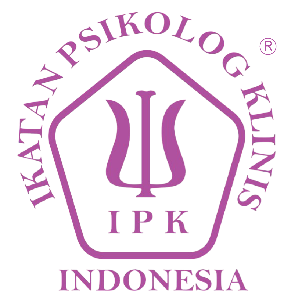Mental Health Literacy and Psychological Distress Among University Students
DOI:
https://doi.org/10.26740/jptt.v16n03.p229-236Keywords:
College student, mental health literacy, psychological distress.Abstract
Background: Students at Sriwijaya University face various challenges, such as academic pressure, which can lead to psychological distress if not managed properly. Objective: This study examines the relationship between mental health literacy (MHL) and psychological distress among undergraduates at Sriwijaya University, hypothesizing that higher MHL correlates with lower distress levels. Method: Using a quantitative survey method, data were collected from 361 students and analyzed using the Pearson product-moment correlation (r=0.122, p<0.05), independent t-test compares two groups, while one-way ANOVA analyzes more than two groups. Results: We observed an unexpected pattern, a significant yet negligible positive correlation. This suggests students with higher MHL reported slightly greater distress, contradicting our initial hypothesis. Conclusion: Despite this unexpected association, we emphasize the continued importance of MHL education through campus programs. We recommend improvements in mental health literacy, particularly in first-aid skills, help-seeking behavior, and self-help strategies, as early protective measures in universities. Future studies should also examine additional variables that may reduce psychological distress.
Abstrak
Latar Belakang: Mahasiswa di Universitas Sriwijaya menghadapi berbagai tantangan seperti tekanan akademik yang dapat menyebabkan distres psikologis jika tidak dikelola dengan baik. Tujuan: Penelitian ini mengkaji hubungan antara literasi kesehatan mental (LKM) dan distres psikologis di kalangan mahasiswa Universitas Sriwijaya, dengan hipotesis bahwa LKM yang lebih tinggi berhubungan dengan tingkat distres yang lebih rendah. Metode: Menggunakan metode survei kuantitatif, data dikumpulkan dari 361 mahasiswa dan dianalisis menggunakan korelasi Pearson’s product moment(r=0.122, p<0.05), independent sample t-test membandingkan dua kelompok populasi, sedangkan one-way ANOVA untuk analisis lebih dari dua populasi. Hasil: Kami mengamati pola yang tidak terduga, korelasi positif yang signifikan namun dapat diabaikan antara LKM dan distres psikologis. Hal ini menunjukkan bahwa mahasiswa dengan LKM yang lebih tinggi melaporkan distres yang sedikit lebih besar, yang bertentangan dengan hipotesis kami. Kesimpulan: Meskipun ada asosiasi yang tidak terduga ini, kami menekankan pentingnya pendidikan LKM yang berkelanjutan melalui program-program kampus. Kami merekomendasikan peningkatan literasi kesehatan mental, khususnya pada aspek first aid skills and help-seeking behavior, dan self-help strategies, sebagai langkah protektif dini di lingkungan universitas. Studi selanjutnya juga perlu meneliti variabel tambahan yang dapat mengurangi tekanan psikologis.
References
Arum, R. P., & Wibawanti, I. (2023). Hubungan antara efikasi diri dan dukungan sosial dengan stres akademik pada mahasiswa yang sedang menyelesaikan skripsi di Fakultas Psikologi UPI YAI. Jurnal Psikologi Kreatif Inovatif, 3(1), 73–84. doi:https://doi.org/https://doi.org/10.37817/psikologikreatifinovatif.v3i1.2144
Campos, L., & Pt, M. (2022). Mental health literacy questionnaire-short version for adults. 4–11. doi: https://doi.org/10.1186/s12888-022-04308-0
Collin, V., O’Selmo, E., & Whitehead, P. (2020). Stress, psychological distress, burnout and perfectionism in UK dental students. British Dental Journal, 229(9), 605–614. doi:https://doi.org/10.1038/s41415-020-2281-4
Eskin, M., Sun, J. M., Abuidhail, J., Yoshimasu, K., Kujan, O., Janghorbani, M., Flood, C., Carta, M. G., Tran, U. S., Mechri, A., Hamdan, M., Poyrazli, S., Aidoudi, K., Bakhshi, S., Harlak, H., Moro, M. F., Nawafleh, H., Phillips, L., Shaheen, A., … Voracek, M. (2016). Suicidal behavior and psychological distress in university students: A 12-nation study. Archives of Suicide Research, 20(3), 369–388. doi:https://doi.org/10.1080/13811118.2015.1054055
Fatahya, & Abidin, F. A. (2022). LiterasiKesehatan MentalDewasa Awal Pengguna Media Sosial. Journal of Public Health Research and Development, 6(2), 165–175. doi:http://journal.unnes.ac.id/sju/index.php/higeia
Figas, K., Chandler, T., Niles, M., Chehoski, B., Parham, B., & Weist, M. D. (2024). Qualitative Evaluation of the Impact of a School Mental Health Literacy Curriculum on Student–Teacher Relationships. Behavioral Sciences, 14(8). doi:https://doi.org/10.3390/bs14080649
Gritsenko, V., Skugarevsky, O., Konstantinov, V., Khamenka, N., Marinova, T., Reznik, A., & Isralowitz, R. (2021). COVID 19 Fear, Stress, Anxiety, and Substance Use Among Russian and Belarusian University Students. International Journal of Mental Health and Addiction, 19(6), 2362–2368. doi:https://doi.org/10.1007/s11469-020-00330-z
Guo, S., Yang, Y., Liu, F., & Li, F. (2020). The awareness rate of mental health knowledge among Chinese adolescent: A systematic review and meta-analysis. Medicine (United States), 99(7), 1–8. doi:https://doi.org/10.1097/MD.0000000000019148
Habibah, U., Syakurah, R. A., Ikhsan, D. S., Zulissetiana, E. F., & Aini, S. (2021). Depression, anxiety, and stress among students of Sriwijaya University. Indigenous: Jurnal Ilmiah Psikologi, 6(3), 23–35. doi:https://doi.org/10.23917/indigenous.v6i3.12629
Hartini, N., Fardana, N. A., Ariana, A. D., & Wardana, N. D. (2018). Stigma toward people with mental health problems in Indonesia. Psychology Research and Behavior Management, 11, 535–541. doi:https://doi.org/10.2147/PRBM.S175251
Hendarto, W. T., & Ambarwati, K. D. (2020). Jurnal Jurusan Bimbingan Konseling Undiksha. Jurnal Ilmiah Bimbingan Konseling Undiksha, 11(2), 165–177. doi:https://doi.org/http://dx.doi.org/10.23887/jibk.v10i2
Idham, A. F., Rahayu, P., As-Sahih, A. A., Muhiddin, S., & Sumantri, M. A. (2019). Trend Literasi Kesehatan Mental Trend of Mental Health Literacy. Jurnal Magister Psikologi UMA, 11(1), 12–20. doi:http://dx.doi.org/10.31289/analitika.v11i1.2294
Jorm, A. F. (2012). Mental health literacy; empowering the community to take action for better mental health. American Psychologist, 67(3), 231–243. doi:https://doi.org/10.1037/a0025957
Jorm, A. F., Korten, A. E., Jacomb, P. A., Christensen, H., Rodgers, B., & Pollitt, P. (1997). “Mental health literacy”: A survey of the public’s ability to recognise mental disorders and their beliefs about the effectiveness of treatment. Medical Journal of Australia, 166(4), 182–186. doi:https://doi.org/10.5694/j.1326-5377.1997.tb140071.x
Kantaş Yilmaz, F., & Ünkür, P. (2023). Kantaş Yılmaz & ÜNKÜR, 2023.pdf (pp. 9–20). doi:https://doi.org/10.22038/jhl.2022.66098.1308
Lai, H. J., Lien, Y. J., Chen, K. R., & Lin, Y. K. (2022). The Effectiveness of Mental Health Literacy Curriculum among Undergraduate Public Health Students. International Journal of Environmental Research and Public Health, 19(9). doi:https://doi.org/10.3390/ijerph19095269
Mardhiyah, S. A. (2021). Analysis of Mental Health Literacy and Psychological Distress As Predictors of Psychological Well-Being in Sriwijaya University Students. Mental Health: Global Challenges Journal, 4(1). doi:https://doi.org/10.32437/mhgcj.v4i1.114
Mardhiyah, S. A., Iswani, R. D., & Juniarly, A. (2019). Inisiasi Mental Health Awareness Melalui Screening dan Promosi Kesehatan Mental Pada Mahasiswa Universitas Sriwijaya. Jurnal Pengabdian Sriwijaya, 7, 906–914.
Marwood, M. R., & Hearn, J. H. (2019). Evaluating mental health literacy in medical students in the United Kingdom. Journal of Mental Health Training, Education and Practice, 14(5), 339–347. doi:https://doi.org/10.1108/JMHTEP-01-2019-0001
Musabiq, S., & Karimah, I. (2018). Gambaran Stress dan Dampaknya Pada Mahasiswa. Insight: Jurnal Ilmiah Psikologi, 20(2), 74. doi:https://doi.org/10.26486/psikologi.v20i2.240
Naylor, R. (2022). Key factors influencing psychological distress in university students: the effects of tertiary entrance scores. Studies in Higher Education, 47(3), 630–642. doi:https://doi.org/10.1080/03075079.2020.1776245
Nelson, L. J. (2021). The Theory of Emerging Adulthood 20 Years Later: A Look at Where It Has Taken Us, What We Know Now, and Where We Need to Go. Emerging Adulthood, 9(3), 179–188. doi:https://doi.org/10.1177/2167696820950884
Nguyen, P., Corona, R., DeCarlo, M. P., Yaros, A., Le, A. T., & Compton, K. (2018). Help Seeking Behavior in a Diverse Sample of Asian American Adults. Journal of Ethnic and Cultural Studies, 5(2), 1–15. doi:https://doi.org/10.29333/ejecs/124
Nolan, K., Mooney, A., & Bergin, S. (2019). An Investigation of Gender Differences in Computer Science Using Physiological, Psychological and Behavioural Metrics. ACM International Conference Proceeding Series, 47–55. doi:https://doi.org/10.1145/3286960.3286966
Pehlivan, Ş., Tokur Kesgi̇n, M., & Uymaz, P. (2021). Psychological distress and mental health literacy in university students. Perspectives in Psychiatric Care, 57(3), 1433–1441. doi:https://doi.org/10.1111/ppc.12709
Rabbani, M. R., & Wahyudi, H. (2023). Pengaruh Academic Self-Efficacy terhadap Stress Akademik Mahasiswa yang sedang Mengerjakan Skripsi. Bandung Conference Series: Psychology Science, 3(1), 202–211. doi:https://doi.org/10.29313/bcsps.v3i1.5188
Rahayu, M. N. M., & Arianti, R. (2020). Penyesuaian Mahasiswa Tahun Pertama Di Perguruan Tinggi: Studi Pada Mahasiswa Fakultas Psikologi Uksw. Journal of Psychological Science and Profession, 4(2), 73. doi:https://doi.org/10.24198/jpsp.v4i2.26681
Rozali, Y. A., Sitasari, N. W., & Lenggogeni, A. (2021). Meningkatkan Kesehatan Mental Di Masa Pandemic. Jurnal Pengabdian Masyarakat AbdiMas, 7(2). doi:https://doi.org/10.47007/abd.v7i2.3958
Singh, S., Zaki, R. A., Farid, N. D. N., & Kaur, K. (2022). The Determinants of Mental Health Literacy among Young Adolescents in Malaysia. International Journal of Environmental Research and Public Health, 19(6). doi:https://doi.org/10.3390/ijerph19063242
Snoek, F. J., Bremmer, M. A., & Hermanns, N. (2015). Constructs of depression and distress in diabetes: Time for an appraisal. The Lancet Diabetes and Endocrinology, 3(6), 450–460. doi:https://doi.org/10.1016/S2213-8587(15)00135-7
South Dakota State University. (n.d.). Recognizing Students in Distress + Warning Sign. 2020. https://www.sdstate.edu/red-folder/recognizing-students-distress%0Awarning-sign
St. Mary’s College of Maryland. (2015). Signs and Symptoms of Distress in Students. https://www.smcm.edu/wellness/help-a-student/signs-and-symptoms-of-distress-in-students/
Sugiyono. (2019). Metode Penelitian Kuantitatif, Kualitatif, dan R&D. Alphabet.
Vicario-merino, A. (2020). iMedPub Journals in the Spanish COVID-19 Confinement Noemi Muñoz-Agustin Abstract. April, 0–6. doi:https://doi.org/10.36648/1791-809X.14.2.707
Downloads
Published
How to Cite
Issue
Section
License
Copyright (c) 2025 Muhamat Akil Shirod, Sayang Ajeng Mardhiyah

This work is licensed under a Creative Commons Attribution 4.0 International License.
Authors who publish in this journal agree to the following terms:
Copyright in any article is held by the author.
The author grants the journal, publication rights with the work simultaneously licensed under a Creative Commons Attribution License that allows others to share the work with an acknowledgment of the work's authorship and initial publication in this journal.
Authors may enter into separate, additional contractual arrangements for the non-exclusive distribution of the journal's published version of the work (e.g., posting it to an institutional repository or publishing it in a book), with an acknowledgment of its initial publication in this journal.
Authors are permitted and encouraged to post their work online (e.g., in an institutional repository or on their website) prior to and during the submission process, as this can lead to productive exchanges, as well as earlier and greater citation of published work.
 Abstract views: 246
,
Abstract views: 246
, PDF Downloads: 180
PDF Downloads: 180


















